Intel Core i7-11700K Review: Blasting Off with Rocket Lake
by Dr. Ian Cutress on March 5, 2021 4:30 PM EST- Posted in
- CPUs
- Intel
- 14nm
- Xe-LP
- Rocket Lake
- Cypress Cove
- i7-11700K
Gaming Tests: Gears Tactics
Remembering the original Gears of War brings back a number of memories – some good, and some involving online gameplay. The latest iteration of the franchise was launched as I was putting this benchmark suite together, and Gears Tactics is a high-fidelity turn-based strategy game with an extensive single player mode. As with a lot of turn-based games, there is ample opportunity to crank up the visual effects, and here the developers have put a lot of effort into creating effects, a number of which seem to be CPU limited.
Gears Tactics has an in-game benchmark, roughly 2.5 minutes of AI gameplay starting from the same position but using a random seed for actions. Much like the racing games, this usually leads to some variation in the run-to-run data, so for this benchmark we are taking the geometric mean of the results. One of the biggest things that Gears Tactics can do is on the resolution scaling, supporting 8K, and so we are testing the following settings:
- 720p Low, 4K Low, 8K Low, 1080p Ultra
For results, the game showcases a mountain of data when the benchmark is finished, such as how much the benchmark was CPU limited and where, however none of that is ever exported into a file we can use. It’s just a screenshot which we have to read manually.
If anyone from the Gears Tactics team wants to chat about building a benchmark platform that would not only help me but also every other member of the tech press build our benchmark testing platform to help our readers decide what is the best hardware to use on your games, please reach out to ian@anandtech.com. Some of the suggestions I want to give you will take less than half a day and it’s easily free advertising to use the benchmark over the next couple of years (or more).
As with the other benchmarks, we do as many runs until 10 minutes per resolution/setting combination has passed. For this benchmark, we manually read each of the screenshots for each quality/setting/run combination. The benchmark does also give 95th percentiles and frame averages, so we can use both of these data points.
| AnandTech | Low Resolution Low Quality |
Medium Resolution Low Quality |
High Resolution Low Quality |
Medium Resolution Max Quality |
| Average FPS | 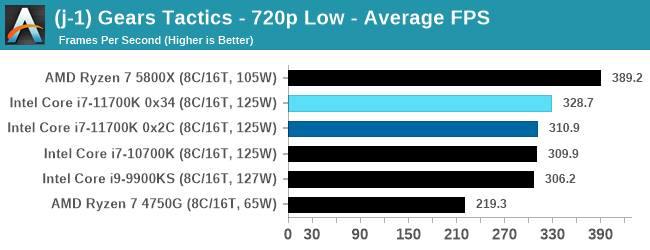 |
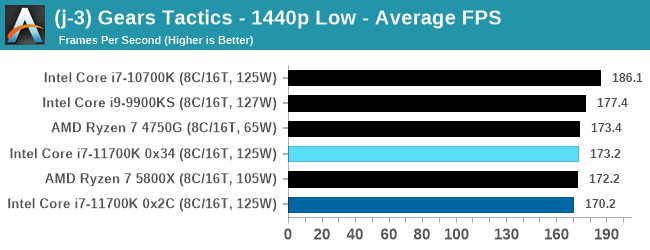 |
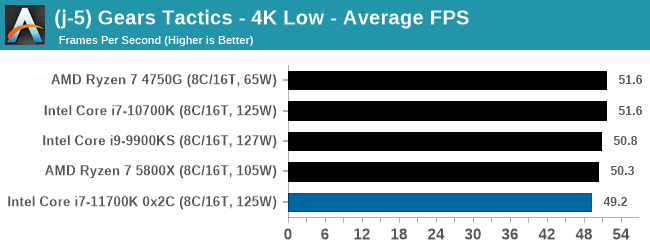 |
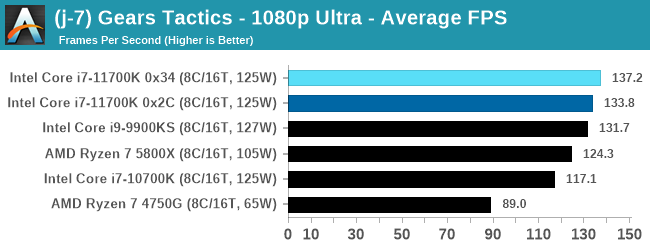 |
| 95th Percentile | 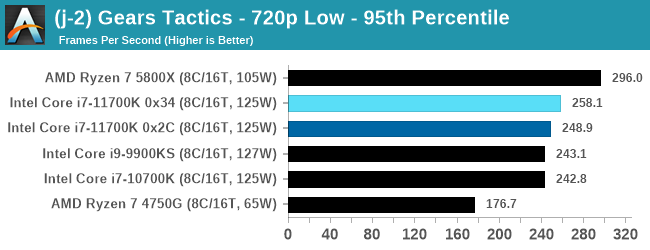 |
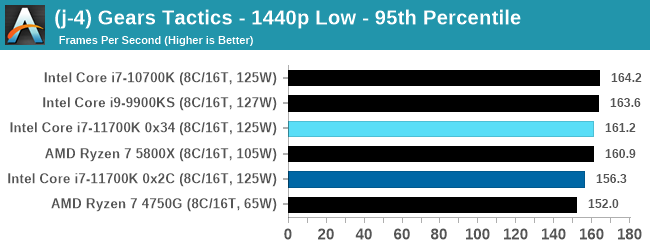 |
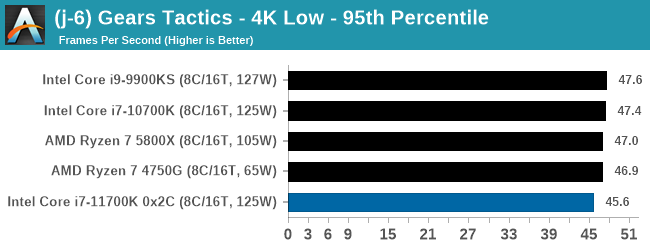 |
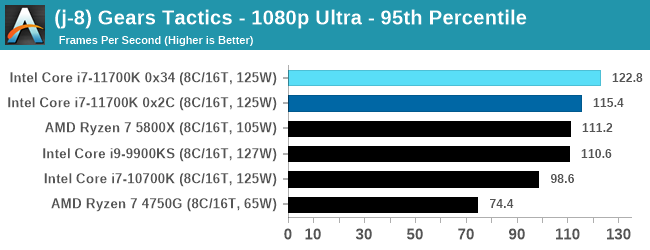 |
Gears is the one test where at our 1080p Maximum settings it shines ahead of the pack. Although at high resolution, low quality, although all five CPUs are essentially equal, it still sits behind AMD's Ryzen APU.
All of our benchmark results can also be found in our benchmark engine, Bench.


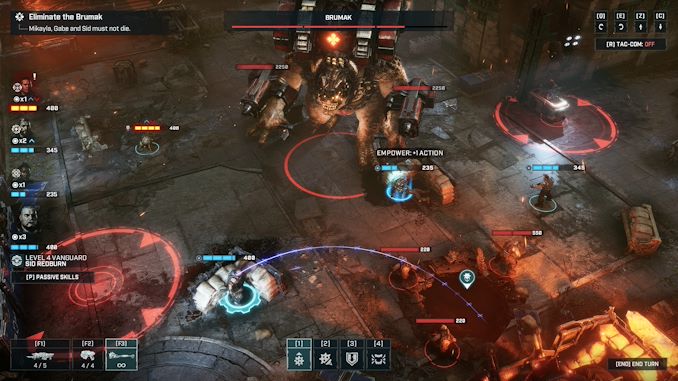









541 Comments
View All Comments
TheinsanegamerN - Friday, March 5, 2021 - link
That 14nm chip pulls over twice the power of the 7nm 16 core chip and is consistently slower then 7nm 8 core chip.It's not so much "right behind them" but rather "barely keeping up while burning through a nuclear reactor's power output".
CiccioB - Friday, March 5, 2021 - link
Twice the power for being slower?If you are referring to the 290W power consumption with AVX-512 test, I'm desolate to inform you that a 7nm CPU with twice the core would not reach those performances and perf/W in that test.
If you are talking about the 140-160W usage at other "normal" tests, I'm desolate to inform you that a 16 core 7nm CPU does not consumes 80W.
So stop vomiting meaningless numbers. This is a 14nm CPU and for the process it is build on it is doing miracles. If Intel could ever use an advanced PP like those 7nm by TSMC Zen would still be the underdog.
For the future just hope the TMSC 5nm are good, early, low cost and really high yielding, because if Intel comes with a decent 7nm I think AMD will not look all that advanced (6 years to surpass a 6 years old architecture and all by the use of a more advanced PP that unfortunately doesn't allow for great deliveries).
blppt - Friday, March 5, 2021 - link
"So stop vomiting meaningless numbers. This is a 14nm CPU and for the process it is build on it is doing miracles. If Intel could ever use an advanced PP like those 7nm by TSMC Zen would still be the underdog."Not necessarily. Intel apparently is still behind in IPC/single thread performance, as evidenced by that Cinebench results, so whilst 7nm would let it run with less power (theoretically), it still would lose to its main competitor, the 5800X.
CiccioB - Friday, March 5, 2021 - link
You have missed that with 14nm die area you cannot improve the architecture that much.You are still thinking that CPU designed for 7nm, with all the advantages that they would bring, would still be like Skylake which is a 6 years old architecture
A PP like TSMC 7nm would bring a completely new architecture that would blow Zen away.
Zen is good because it is based on such a better PP that those Intel has now, but it still struggles at beating Skylake. And to do that it, that is by using such an advanced but production limited PP, it has sacrificed high stock delivery right in the period where demand is much higher than supply.
Intel can fill the remaining market with whatever it has, being it 9xxx, 10xx or now 11xx generations.
barich - Friday, March 5, 2021 - link
Yes, Intel probably would beat AMD with an imaginary all-new architecture on TSMC's 7nm process. Similarly, I would be a hell of a basketball player if I were a foot taller and had any motor skills.Here in reality, Intel has worse performance and worse efficiency. As a consumer, that's what matters to me. What Intel could do with a bunch of "ifs" is irrelevant. I haven't owned an AMD CPU since my Athlon 64 was replaced by a Core 2 Duo. But there's no way my new build this year isn't going to be AMD.
CiccioB - Saturday, March 6, 2021 - link
Yes, what counts is the results, you are right.But by that I can't cry for a miracle when I see Zen 3 results as with a much more advanced PP it just can win over Skylake for a few % and all the real advantages it has is smaller power consumption due to the much better PP vs this one 6 years old.
If you look at the real power consumption, that is not the one with AVX-512 tests where RKL disintegrates Zen for perf/W despite the high power requirements, you'll see that this chip is not that power hungry (though being more power hungry than Zen) and that does make me think that with a better PP this same architecture would be another thing completely, as are the 10nm Tiger Lake which however suffer the not so good power consumption at higher frequency required by desktop SKUs.
As we are not that distant from finally having something decent that is not the 14nm PP, I will really not call my thought "imaginary". AMD will not be able to pass to 5nm so soon, and seen what this architecture can do, despote the 14nm PP, I think that the future is going to be more interesting that what you hope it ti be (that is, AMD keeps on figure it has better CPUs while not having them in the shelves but what counts for you are.. yes the results... and for these Intel is outselling AMD 5:1).
blppt - Saturday, March 6, 2021 - link
"A PP like TSMC 7nm would bring a completely new architecture that would blow Zen away."Based on what, exactly? We've seen die shrinks before without amazing architectural advances from both Intel and AMD. You have an awful lot of confidence in something that doesn't exist.
CiccioB - Saturday, March 6, 2021 - link
Based on the fact that with a 7nm PP AMD still struggles at beating Skylake architecture which is 6 years old and was born on... oh yes, 14nm.schujj07 - Saturday, March 6, 2021 - link
Zen2 was already faster than Skylake and its derivatives clock for clock by about 7%. While Comet Lake had higher single threaded performance than Zen2, it did so by throwing efficiency and power draw out the window and going for absolute performance. That made it such that Comet Lake could compete in ST applications but it still lost on MT applications against the same thread counted AMD CPUs. Going for absolute performance has been a double edged sword for Intel as the newer architectures hadn't been able to clock as high. Despite the higher IPCs of the newer architectures, absolute performance was no better than a wash due to 20% lower clock speeds.Zen3 now has absolute performance dominance over any Skylake architecture CPU. It doesn't "just" beat the older CPU, as in like 2% faster. It is upwards of 20% faster clock for clock and 10%+ faster in absolute ST performance.
blppt - Saturday, March 6, 2021 - link
"Based on the fact that with a 7nm PP AMD still struggles at beating Skylake architecture which is 6 years old and was born on... oh yes, 14nm."Struggles? The slightly older AMD chip (5800X) beats the newest and greatest out of Intel, whilst consuming less power, AND hitting lower peak turbo speeds.
That is complete domination. You could make the same argument about how Intel hadn't even made any significant gains over Sandy Bridge until Skylake, and that was *2* die shrinks.